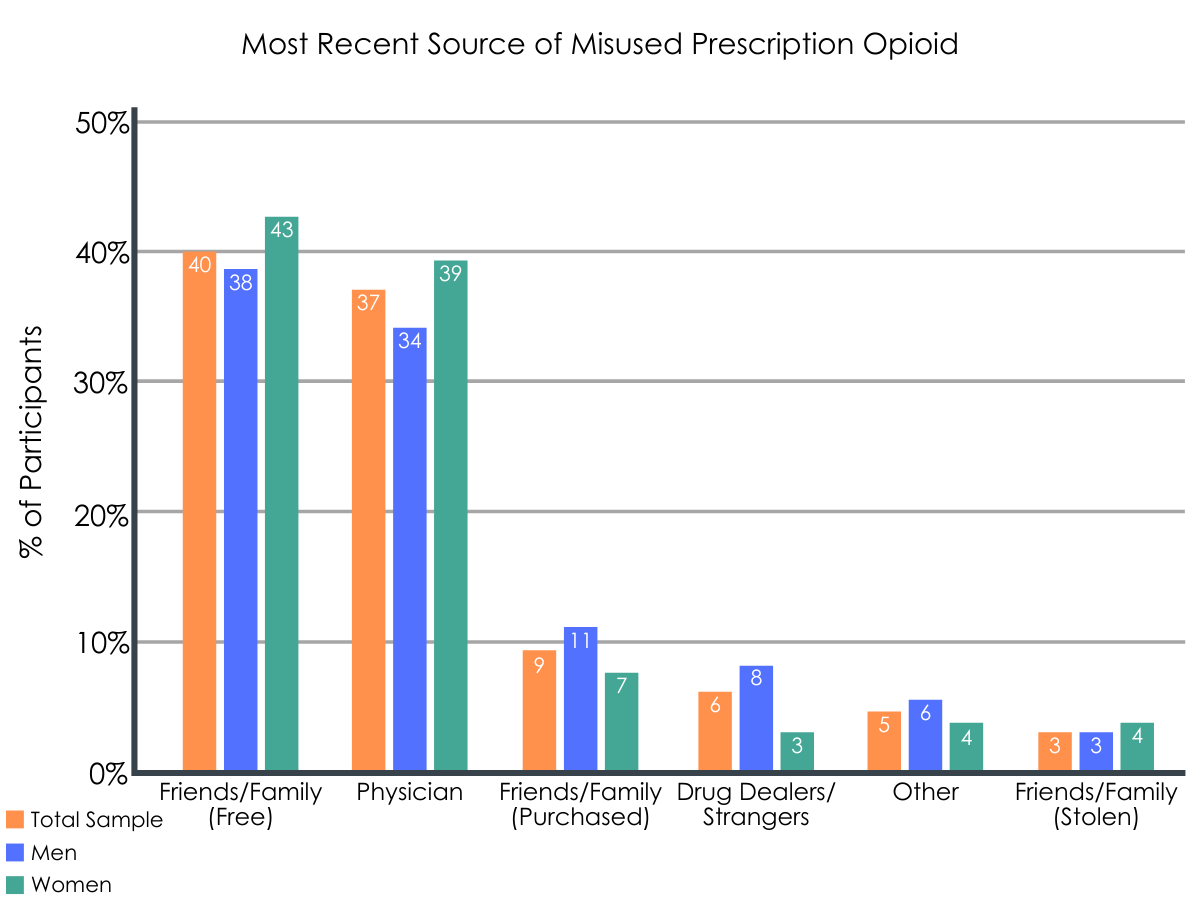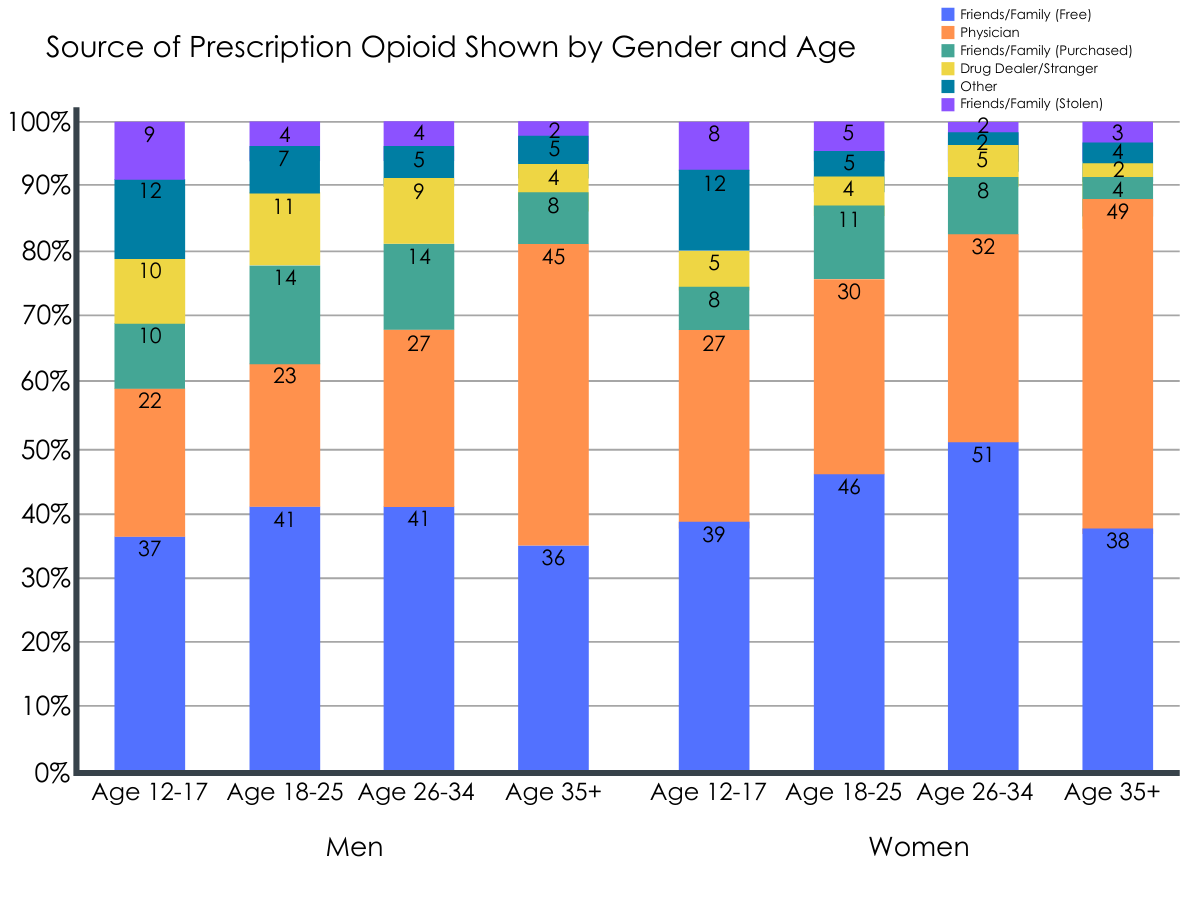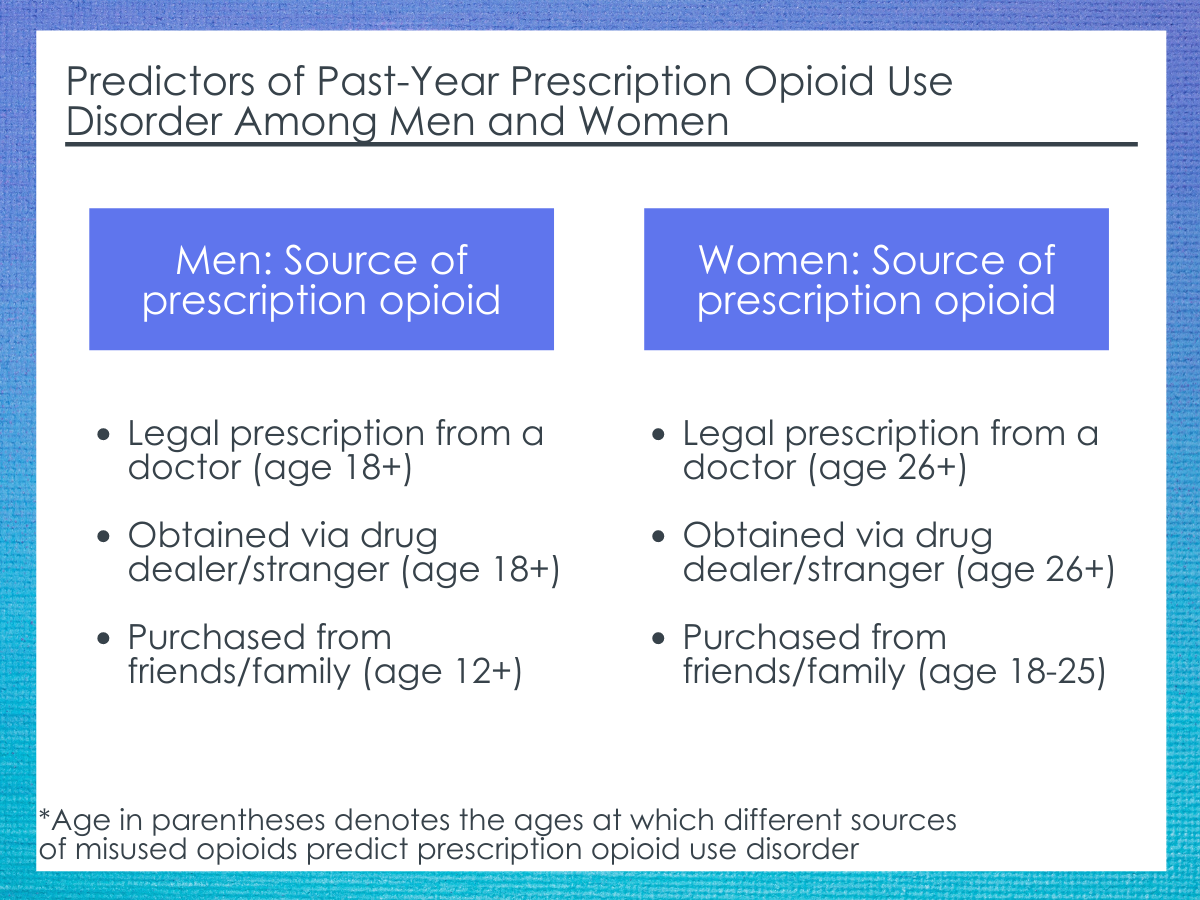Where do individuals get the prescription opioids they misuse?
In the U.S., 9.9 million Americans have misused prescription opioids in the past year, and 1.7 million have prescription opioid use disorder. Despite efforts to address the opioid overdose epidemic in the United States, as well as growing research assessing the source of misused opioids, greater understanding of the relationships among individuals’ gender and age, where they obtain the prescription opioids that they misuse, and risk for opioid use disorder can inform prevention and treatment efforts. In this study, authors used a nationally representative sample of adolescents and adults to examine these important research questions related to prescription opioid misuse in the U.S.
WHAT PROBLEM DOES THIS STUDY ADDRESS?
An estimated 9.9 million Americans aged 12 and older have misused prescription opioids in the past year, and about 1.7 million meet criteria for prescription opioid use disorder – meaning they continue to use prescription opioids despite consequences and other negative impacts on their day-to-day functioning. Furthermore, more than 47,000 Americans died of an opioid related overdose in 2017, with 36% of these deaths attributable to prescription opioids. To effectively address the U.S. opioid overdose epidemic, through both enhanced treatment and prevention, it is essential to better understand the ways in which individuals obtain misused prescription opioids. One means for obtaining them is diversion, which is the illegal sharing or selling of prescription medications to individuals for whom the prescription was not written.
Importantly, different sources of prescription opioids might indicate different levels of risk for progression from opioid misuse to opioid use disorder. For example, prior work has shown that buying prescription opioids from dealers is a significant marker that predicts increased risk of developing opioid use disorder, whereas obtaining for free from family/friends predicts decreased risk.
Several factors have the potential to influence opioid misuse patterns and the manner in which they are obtained. Two factors shown to play a role in these patterns include someone’s gender and how old they are. Studies suggest there are differences between males and females in the primary source from which prescription opioids are obtained. For example, female adolescents may be more likely to obtain prescription opioids via friends/relatives than male adolescents. Risk of opioid misuse and opioid use disorder are also shown to vary by gender, with women being more likely to misuse prescription opioids, and progress more rapidly to prescription opioid use disorder.
Age might also play a role in opioid misuse. Although prescription opioid misuse typically starts in adolescence and peaks between the ages of 18 and 21, rates of misuse and overdose are affecting an increasing number of older adults. Recent research suggests that younger individuals might be more likely to obtain prescription opioids from their social circles and drug dealers, whereas physicians sources may be more common among older individuals.
Though studies have documented age- and gender-based differences in prescription opioid misuse and where the prescription opioids come from (sources), these demographic factors are seldom assessed together in the context of opioid misuse research. Understanding their influence more might lead to the development of better interventions aimed at specific subgroups of individuals (e.g., adolescent boys). To address this knowledge gap, this study examined the source of misused prescription opioids, the relationship between source and past-year prescription opioid use disorder, and the influence of gender and age using a nationally representative sample.
HOW WAS THIS STUDY CONDUCTED?
The authors conducted a secondary data analysis on a subset of 6,033 individuals from the 2015-2016 National Survey on Drug Use and Health (NSDUH). The NSDUH is a nationally representative survey, providing U.S. population estimates of substance use and mental health conditions.
All individuals included in the current analysis were aged 12+ and reported opioid misuse within the past-year. Misuse was defined as (1) use without a prescription, (2) using opioids in greater amounts, more frequently, or for longer than prescribed, or (3) use in any way not directed by the doctor (e.g., crushing and injecting the opioid medication, instead of taking it orally). Past year prescription opioid use disorder was defined as meeting abuse / dependence criteria within the past 12 months, based on the diagnostic and statistical manual of mental disorders (fourth edition), or DSM IV.
To evaluate the source of opioid misuse, individuals were asked about how they obtained their most recent misused prescription opioid, which included: (1) obtained from one or more doctors, (2) obtained for free from friends/family, (3) bought from friends/family, (4) stole from friend/family, (5) bought from drug dealer or stranger, (6) obtained in another way (e.g., stole from hospital, clinic, pharmacy).
To examine age and gender effects, male and female participants were each grouped into 1 of 4 age categories: (1) 12-17 years, (2) 18-25 years, (3) 26-34 years, and (4) 35+ years. Individuals falling in the last two age categories were combined into a 26+ category when relationships between source and opioid use disorder were assessed. The authors controlled for several demographic and substance-use factors to ensure that they were capturing the source of misused prescription opioids and its relationship to the variables of interest, without the influence of other factors. Analyses controlled for: the year in which data were collected, race, ethnicity, household income, population density, health insurance, overall health, frequency of prescription opioid misuse in the past month, past-year initiation of prescription opioid misuse, and past-year major depressive episode, alcohol use disorder, heroin use disorder, or non-opioid drug use disorder.
The majority of participants were non-Hispanic white (66%) men (55%) with relatively low family incomes (55% < $50,000), living in large metropolitan U.S. regions (54%). Rates of past-year prescription opioid use disorder, heroin use disorder, non-opioid drug use disorder, and alcohol use disorder were 17%, 4%, 18%, and 22%, respectively.
WHAT DID THIS STUDY FIND?
Source of most recently misused opioid:
- Across the entire sample, the majority of individuals obtained their most recently misused prescription opioid for free from family/friends (40%), or from a legal physician prescription (37%).
- Compared to women, men were more likely to have purchased their most recently misused prescription opioids from friends/family (11% vs. 7%), and from drug dealers/strangers (8% vs. 3%).

Figure 1.
- When compared to individuals 35+ years of age, male and female adolescents aged 12-17 were less likely to obtain their misused prescription opioid from a physician.
- Among males, those aged 12-17 year were also more likely than those aged 35+ years to purchase prescription opioids from drug dealers/strangers, steal them from friends/family, and obtain via ‘other’ means.
- Among females, individuals aged 12 to 17 were more likely than those aged 35+ years to buy prescription opioids from friends/family, and more likely than those aged 26-34 years to steal them from friends/family, but less likely to obtain opioids from friends/family for free.

Figure 2.
Relationships between source and past-year opioid use disorder:
- Purchasing from a drug dealer/stranger generally was the strongest predictor of past-year prescription opioid use disorder.
- When age and gender were considered, the authors found that purchasing from drug dealers/strangers and obtaining via physician were associated with increased likelihood of prescription opioid use disorder among men aged 18+ and among women aged 26+. Buying from friends/family was associated with increased likelihood of prescription opioid use disorder among male individuals ages 12+ and among women ages 18-25.
WHAT ARE THE IMPLICATIONS OF THE STUDY FINDINGS?

Figure 3.
This study helps us understand the ways in which people obtain the prescription opioids that they misuse, how certain sources might contribute to the development/management of prescription opioid use disorder, and how demographic factors might serve as markers for misuse behaviors and disorder risk.
The majority of participants obtained their most recently misused prescription opioid from friends/family for free, or from a physician. Having a physician source was more common among older adults aged 35+, which is in line with previous research. With opioid misuse prevalence continuing to rise among older adults, rates are expected to double between 2004 and the end of 2020. Therefore, caution may be warranted when prescribing to this age group and additional time and effort may be needed to review the risks of opioid medications and the importance of following prescriber instructions.
Physician prescribing guidelines have been put into place to help curb the role of physician prescribing in prescription opioid misuse. However, implementation of these guidelines is not often not paired with linkage to addiction treatment, ultimately leading to an increase in the use of illicit opioids (e.g., heroin) and related overdose deaths. Therefore, any attempts to address prescription opioid misuse in the context of physician prescribing should be actively paired with screening and referral to treatment. Early screening and intervention methods may be warranted, as they have shown to be effective at preventing the progression of opioid misuse to opioid use disorder.
Prevalence of a free friend/family source was particularly high among women aged 26-34 years, suggesting enhanced caution among this group when it comes to prescription “sharing”. Other sources of misused prescription opioids were less common but varied by gender and age. Among males, purchasing from dealers/strangers and stealing from friends/family was more common among adolescents than older cohorts. Alternatively, female adolescents were more likely to buy and steal prescription opioids from friends/family. These outcomes highlight the enhanced role of family and friends in adolescent prescription opioid misuse.
Storing prescription opioids in a safe and secured place within the home, such as a locked cabinet, might help prevent children and adolescents from stealing medications. Results also point to a higher degree of criminal activity related to opioid seeking among adolescents. Given that ‘other’ source included misuse facilitated by stealing from medical environments, and that, relative to older cohorts, adolescents appeared to have the highest prevalence of ‘other’ source, additional research is needed to determine whether interventions are needed to reduce misuse and opioid-related criminal activity among adolescent populations. Studies are also needed to evaluate sale/purchase within adolescent social circles, and to identify potential interventions to prevent such exchanges, particularly among females.
Regarding relationships between source and opioid use disorder, this study suggests that having past-year prescription opioid use disorder is related to obtaining opioids from physicians, buying from dealers/strangers, and buying from friends/family. Although buying from dealers/strangers was one of the largest risk factors for OUD, it is important to note that only ~6% reported obtaining opioids in this manner. The same sources were associated with past-year prescription opioid use disorder for men and women, however, the pattern of this relationship varied by age. Increased risk of past-year prescription opioid use disorder was noted among males aged 18+ and females aged 26+ with physician or dealer/stranger sources. Increased risk was also observed for males aged 12+ and females between the ages of 18 and 25, who bought opioids from friends/family. Results offer age and gender specific markers of risk, and can be used by clinicians to assess appropriateness for early intervention.
- LIMITATIONS
-
- Misuse does not necessarily translate to an opioid use problem. Individuals who misused even once in the past year were included in this analysis. Therefore, this sample likely represents a broad spectrum of individuals engaged in misuse. Assessing individuals with different levels of severity of misuse will ultimately enhance interpretation.
- The National Survey on Drug Use and Health does not include individuals who are homeless, institutionalized, or on active-duty in the military. Therefore, the outcomes of this study may not apply to these special populations.
- Source was only assessed for the most recent misuse episode and may not represent an individual’s typical source, which has the potential to influence outcomes. Additional research is warranted.
BOTTOM LINE
- For individuals and families seeking recovery: In this study of prescription opioid misuse, authors found that comparatively older adults (age 35+) are more likely to obtain misused opioids from physicians. In contrast, adolescents (12-17) were more likely to obtain opioids from friends/family, including higher rates of stealing among male and female adolescents, and higher rates of buying among female adolescents. Purchasing from a drug dealer, obtaining a physician prescription, and buying from friends/family was related to having a prescription opioid use disorder within the past year. Results highlight the role of family and friends in opioid misuse access among adolescents and the role of prescribers in misuse among middle aged and older adults. Properly and securely storing medications might help prevent adolescent misuse. Misuse among adults might be reduced by greater physician attention to prescribing practices. Recognizing how different youths and men and women of different ages obtain prescription opioids can ultimately help us identify individuals at risk for opioid use disorder, and to implement more timely and effective individualized interventions.
- For treatment professionals and treatment systems: In this nationally representative study of prescription opioid misuse, the authors found that comparatively older adults aged 35+ are most likely to obtain misused opioids from a physician, whereas adolescents (age 12-17) were more likely to obtain them from friends/family by stealing (males & females) and buying (females). Purchasing from a drug dealer, obtaining a physician prescription, and buying from friends/family predicted past-year prescription opioid use disorder. These results highlight important markers for prescription opioid use disorder risk and suggest potential areas for demographic-specific interventions. Communicating with families about their role in preventing prescription misuse and the importance of securely storing prescriptions might help limit adolescent access to opioids. Physicians may also want to take special precautions when prescribing opioids to adults. Clear communication, enhanced education about the dangers of opioids, and more frequent/regular monitoring of patients may help reduce misuse and opioid use disorder risk among middle aged and older adults. Recognizing demographically related prescription opioid misuse behaviors and their relationship to disorder risk may ultimately help physicians identify individuals at risk for opioid use disorder and thus help prevent it or intervene earlier.
- For scientists: Utilizing data from the National Survey on Drug Use and Health, this study found age and gender specific patterns in the source of misused prescription opioids, with physician sources being more common in comparatively older adults age 35+ and friend/family sources being more common in adolescents (age 12-17), including higher rates of stealing (males and females) and buying (females). Purchasing from a drug dealer, obtaining a physician prescription, and buying from friends/family predicted prescription opioid use disorder within the past year in an age and gender dependent manner. Outcomes suggest demographic-specific markers of opioid use disorder risk that might necessitate targeted interventions, and highlight the role of family/friends in adolescent opioid access and the role of prescribers in adult misuse. Given that source was assessed only for the most recent misuse episode, and that sampling did not exclude for a single misuse episode, more research is needed to evaluate the influence of misuse severity. Studies are also needed to evaluate sale/purchase within adolescent social circles, and to identify predictors of prescription opioid use disorder risk among female adolescents, since source did not predict risk of disorder among younger females (age < 18) in this study.
- For policy makers: Utilizing a nationally representative sample, this study found that physicians were the most common source of misused prescription opioids among comparatively older adults aged 35+, whereas adolescents (age 12-17) were more likely to steal and buy opioids from friends/family. Purchasing from a drug dealer, obtaining a physician prescription, and buying from friends/family were associated with prescription opioid use disorder within the past year. Results highlight the role of family and friends in opioid access among adolescents and the role of prescribers in misuse among middle aged and older adults. Identifying demographically related patterns of opioid misuse and opioid use disorder may ultimately help identify individuals at risk and ensure timely and more effective, tailored interventions. Outcomes suggest ongoing need to monitor and limit diversion and illegal sale of prescription opioids, as well as vigilant prescriber practices and opioid prescriber education. Pairing these practices with linkage to low-threshold treatment for those who need it may ultimately help to reduce the incidence of opioid use disorder. Additional funding for opioid research can ultimately aid our understanding of the factors influencing misuse and opioid use disorder development.
CITATIONS
Park, J. Y., & Wu, L. T. (2020). Sources of misused prescription opioids and their association with prescription opioid use disorder in the United States: Sex and age differences. Substance Use & Misuse, 55(6), 928-936. doi:10.1080/10826084.2020.1713818

